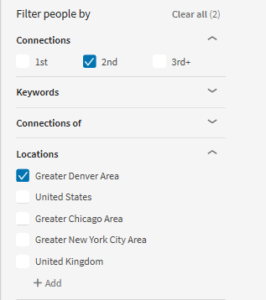 Tim was excited for his wife. She got a promotion with a new title and a nice raise. The only problem: They had to move from Atlanta to Denver. He’s a freelance website designer and can work from anywhere, so he figured he can work from Denver just as easily.
Tim was excited for his wife. She got a promotion with a new title and a nice raise. The only problem: They had to move from Atlanta to Denver. He’s a freelance website designer and can work from anywhere, so he figured he can work from Denver just as easily.
But once he gets there, he realizes that the network of colleagues, clients, and cohorts he had been plugged into is now missing. He’s struggling to find work, doesn’t know who to connect with, and a little depressed.
How can you make sure that doesn’t happen to you when you move to a new town?
Starting Over Instead of Adding On
It can be daunting enough to go to a party or conference where you don’t know anyone, but what happens when you move to a city where you don’t know anyone? Social media and digital communication help a bit and allow you to stay in touch with the old neighborhood. But what is helping you get started in your new world?
When we think about building our network, we’re usually thinking about adding to what we already have. We’re looking to fill it out, not start from scratch. But what should you do when you have to do exactly that: start from scratch.
Think of the stereotypical image of kids transferring to a new school in the middle of the school year. They don’t know anyone and they have no friends to sit with at lunch. It can be sad and lonely and we don’t want to be sad and lonely!
But there’s one difference. You’re an adult now. You can be strategic and you know how to make some new friends. Here are a few easy ways to get started.
7 Steps to Building a New Network
1. Ask your network in the old neighborhood.
This can even be done before you leave for your new digs. Simply ask your existing network if they know anyone in your new city. You’d be surprised at how interconnected the world is. They might have an old co-worker, a college friend, or a sister who lives in your new town. Even if you didn’t have a chance to ask before you left, send them a quick email and ask if they know someone they could introduce you to.
A useful trick is to ask your question in an open-ended fashion. Instead of asking, “Do you know someone who lives in Portland?”, ask “Who do you know who lives in Portland?” The way the human brain works, it will keep working to come up with an answer. It’s not important that they are super-close with that contact, it’s just a place to get started.
 Today, the introduction is the new referral. This statement helps you realize that you can ask for an introduction even if someone has not worked with you. This request has helped a lot of my clients reach back into their network, especially where they live, and ignite that important process of building out your network more effectively.
Today, the introduction is the new referral. This statement helps you realize that you can ask for an introduction even if someone has not worked with you. This request has helped a lot of my clients reach back into their network, especially where they live, and ignite that important process of building out your network more effectively.
–Melissa G Wilson, author Networking is Dead and Networlding
2. Use a LinkedIn search.
 Even if you think LinkedIn is only for job-seekers, this is the perfect time to expand your horizons and leverage its capabilities. Go to LinkedIn and do a search using the filters for 2nd-level connections and your new location. You’ll get a list of people that you are connected to through a mutual contact. I’ve only been to Colorado twice in my life, and I yet have 6,827 2nd-level connections that live Denver.
Even if you think LinkedIn is only for job-seekers, this is the perfect time to expand your horizons and leverage its capabilities. Go to LinkedIn and do a search using the filters for 2nd-level connections and your new location. You’ll get a list of people that you are connected to through a mutual contact. I’ve only been to Colorado twice in my life, and I yet have 6,827 2nd-level connections that live Denver.
Use additional filters to narrow down the list to those in a similar field or position as you. Then ask your mutual connection to introduce you.
“Hi Maria, I see that you know Jim in Denver. I’m moving out there with my wife’s new job in January and I’m looking to make some new connections out there. Would you be comfortable introducing us? I’d love to hit the ground running when I get there and make some new professional relationships in my new home. Thanks!”
3. Become a regular at your local coffeehouse.
This is particularly helpful if you work for yourself or independently (i.e., from home and on your own schedule). Go to your local coffeehouse at about 10:00 or 2:00 a few times a week. Most of the people who are there will be other independent workers. Be friendly with the baristas and learn their name. When you notice the same person a few days in a row, smile at them and say hello. It’s a little longer process, but you never know what types of people you will meet.
4. Reconnect with your alumni association.
 If you haven’t talked to your alma mater since their last fund-raising call, you might want to take a second look. Colleges and universities are more and more committed to providing life-long benefits to their alumni beyond just homecoming weekend. It’s common for schools to have chapters of their alumni association scattered around the country (depending on your school, around the world). While different schools have varying degrees of presence in different areas, it’s worth checking into.
If you haven’t talked to your alma mater since their last fund-raising call, you might want to take a second look. Colleges and universities are more and more committed to providing life-long benefits to their alumni beyond just homecoming weekend. It’s common for schools to have chapters of their alumni association scattered around the country (depending on your school, around the world). While different schools have varying degrees of presence in different areas, it’s worth checking into.
This is a powerful tactic because you already share a common experience which can act as a bridge to start your relationship. You might be new to the area, but you’ll be able to connect over your alma mater’s latest bowl game appearance, or lack thereof. Even busy professionals will usually make a few minutes for a fellow alum. I know that I make time when a fellow Wildcat reaches out to me.
5. Visit a chamber of commerce meeting
Big or small, pretty much every town has a Chamber of Commerce. And one of their main roles is to facilitate connections. So go and get some connections facilitated. Most Chambers will allow a newcomer to the area to attend a few events without becoming a member. You might want to join, but even if you don’t, it will be a good way to jump-start your network.
There are two main places to focus your attention. The first is the Director or President of the Chamber itself. By the nature of their position, they know just about everyone. Let them know that you are new in town, and give them a few specific types of connections you’d like to make. In the same way, identify the “connectors” in the group and befriend them. These are the gregarious members of the group who take pride in the size of their network. They’ll love the chance to introduce the new guy or gal.
 My #1 tip when building new relationships is to befriend and help the super connector. This is the only time I recommend doing work for free. If you can build trust with someone who is already well connected in your desired professional network, you’ve made a huge leap from nothing to super connected.
My #1 tip when building new relationships is to befriend and help the super connector. This is the only time I recommend doing work for free. If you can build trust with someone who is already well connected in your desired professional network, you’ve made a huge leap from nothing to super connected.
–Robbie Abed, author of Fire Me, I Beg You
6. Join the Local Chapter of (Insert Professional Group Here)
 From real estate agents to computer programmers to writers, the members of every profession like to get together with each other for support and commiseration. Depending on your field or industry, there could be many local professional organizations in your area. Look them up online and see if they have any meetings coming up. It can be as simple as doing a Google search on (job title) (city) (organization).
From real estate agents to computer programmers to writers, the members of every profession like to get together with each other for support and commiseration. Depending on your field or industry, there could be many local professional organizations in your area. Look them up online and see if they have any meetings coming up. It can be as simple as doing a Google search on (job title) (city) (organization).If you are struggling to find local groups, check with any national organizations for your field. Contact them and let them know the area that you are in, and that you’d like to find others in your area to connect with. They can point you in the right direction.
 Before you join any group, starting following them on social media and/or subscribe to their newsletter. Then, attend a gathering and introduce yourself to the leaders and ask about opportunities to volunteer. By volunteering, your dedication, competency, and service will be clearly visible and set you apart (and you get side-by-side time with those leaders and influential members).
Before you join any group, starting following them on social media and/or subscribe to their newsletter. Then, attend a gathering and introduce yourself to the leaders and ask about opportunities to volunteer. By volunteering, your dedication, competency, and service will be clearly visible and set you apart (and you get side-by-side time with those leaders and influential members).
–Sandy Jones-Kaminski, author of I’m at a Networking Event-Now What???
7. Leapfrog Your New Connections to More New Connections
All of these ideas are simply jumping off points. They give you a place to start. How do you keep it going? The best way to leverage these new relationships is to ask a simple question at the end of your conversations:
“Thank you so much for chatting with me today. It’s been great finding people to connect with since I’ve moved to Denver. I’d like to continue to rebuild my professional network here with people like you. Who is one person you know that you think I should know? Would you feel comfortable introducing me to them?
This creates a chain of introductions and meetings that will have you building a network that’s even stronger and more robust than the one you left behind.
Happy Networking!
